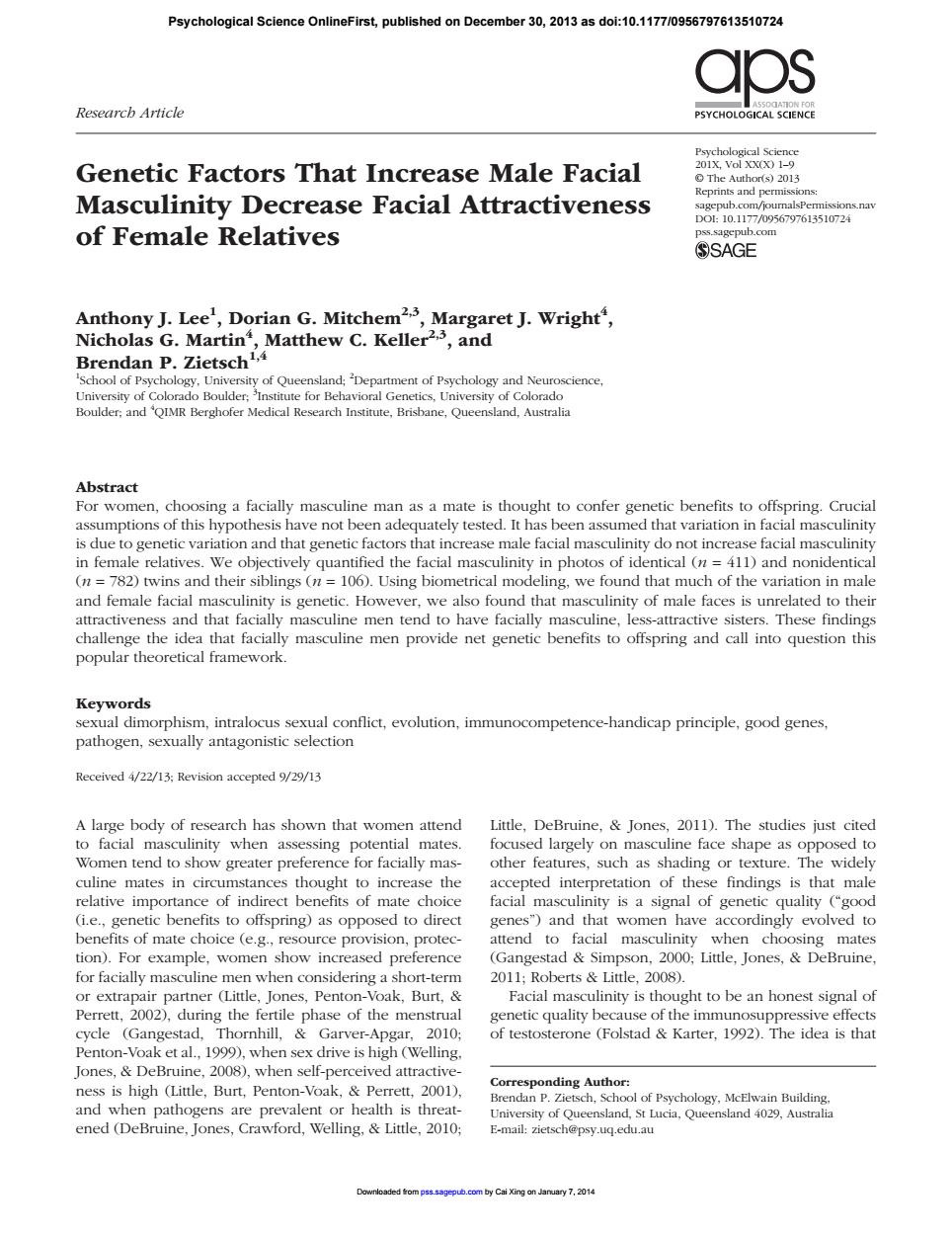正在加载图片...

Psychological Science OnlineFirst,published on December 30,2013 as doi:10.1177/0956797613510724 aos Research Article PSYCHOLOGICAL SCIENCE Genetic Factors That Increase Male Facial ints and per Masculinity Decrease Facial Attractiveness of Female Relatives SAGE aret J.Wright Nich Martin Brendan P.ZietschMatthew C.Keller,and nsland:De for Be Abs en,choosing a facially masculine man as a mate is thought to confer genetic benefits to offspring.Crucial assumptions of this hypothesis have not been adequately tested.It has been assumed that variation in facial masculinity is due to genetic variation and that genetic factors that increase male facial masculinity do not increase facial masculinity cral mas linity in photos ntical 1)an0 nonidenti and female facial n also found that n ale faces is ated to thei attractiveness and that facially masculine men tend to have facially masculine,less-attractive sisters.These findings challenge the idea that facially masculine men provide net genetic benefits to offspring and call into question this popular theoretical framework Keywords sexual dimorphism,intralocus sexual conflict,evolution,immunocompetence-handicap principle,good genes. pathogen,sexually antagonistic selection Received 4/22/13:Revision accepted 9/29/13 Little,DeBruine,&Jones The studies just cited other features such as shading or texture The widely culine mates in circumstances thought to increase the accepted interpretation of these findings is that male relative importance of indirect benefits of mate choice facial masculinity is a signal of genetic quality ("good (.e.,genetic bene toopring)as opposed to direct )and women ave accord ngly evolved to en od&si for facially masculine men when considering a short-term 2011:Roberts Little 2008) Facial masculinity is thought to be an honest signal of 2002),dun nng the fe ile phase of the menstrual Penton-Voaketal 1999 whe Jones Depruine.200),when ness is high (Little,Burt,Penton-Voak,Perrett,2001), CoPsychological Science 201X, Vol XX(X) 1–9 © The Author(s) 2013 Reprints and permissions: sagepub.com/journalsPermissions.nav DOI: 10.1177/0956797613510724 pss.sagepub.com Research Article A large body of research has shown that women attend to facial masculinity when assessing potential mates. Women tend to show greater preference for facially masculine mates in circumstances thought to increase the relative importance of indirect benefits of mate choice (i.e., genetic benefits to offspring) as opposed to direct benefits of mate choice (e.g., resource provision, protection). For example, women show increased preference for facially masculine men when considering a short-term or extrapair partner (Little, Jones, Penton-Voak, Burt, & Perrett, 2002), during the fertile phase of the menstrual cycle (Gangestad, Thornhill, & Garver-Apgar, 2010; Penton-Voak et al., 1999), when sex drive is high (Welling, Jones, & DeBruine, 2008), when self-perceived attractiveness is high (Little, Burt, Penton-Voak, & Perrett, 2001), and when pathogens are prevalent or health is threatened (DeBruine, Jones, Crawford, Welling, & Little, 2010; Little, DeBruine, & Jones, 2011). The studies just cited focused largely on masculine face shape as opposed to other features, such as shading or texture. The widely accepted interpretation of these findings is that male facial masculinity is a signal of genetic quality (“good genes”) and that women have accordingly evolved to attend to facial masculinity when choosing mates (Gangestad & Simpson, 2000; Little, Jones, & DeBruine, 2011; Roberts & Little, 2008). Facial masculinity is thought to be an honest signal of genetic quality because of the immunosuppressive effects of testosterone (Folstad & Karter, 1992). The idea is that 510724PSSXXX10.1177/0956797613510724Lee et al.Genetics of Facial Masculinity research-article2013 Corresponding Author: Brendan P. Zietsch, School of Psychology, McElwain Building, University of Queensland, St Lucia, Queensland 4029, Australia E-mail: zietsch@psy.uq.edu.au Genetic Factors That Increase Male Facial Masculinity Decrease Facial Attractiveness of Female Relatives Anthony J. Lee1 , Dorian G. Mitchem2,3, Margaret J. Wright4 , Nicholas G. Martin4 , Matthew C. Keller2,3, and Brendan P. Zietsch1,4 1 School of Psychology, University of Queensland; 2 Department of Psychology and Neuroscience, University of Colorado Boulder; 3 Institute for Behavioral Genetics, University of Colorado Boulder; and 4 QIMR Berghofer Medical Research Institute, Brisbane, Queensland, Australia Abstract For women, choosing a facially masculine man as a mate is thought to confer genetic benefits to offspring. Crucial assumptions of this hypothesis have not been adequately tested. It has been assumed that variation in facial masculinity is due to genetic variation and that genetic factors that increase male facial masculinity do not increase facial masculinity in female relatives. We objectively quantified the facial masculinity in photos of identical (n = 411) and nonidentical (n = 782) twins and their siblings (n = 106). Using biometrical modeling, we found that much of the variation in male and female facial masculinity is genetic. However, we also found that masculinity of male faces is unrelated to their attractiveness and that facially masculine men tend to have facially masculine, less-attractive sisters. These findings challenge the idea that facially masculine men provide net genetic benefits to offspring and call into question this popular theoretical framework. Keywords sexual dimorphism, intralocus sexual conflict, evolution, immunocompetence-handicap principle, good genes, pathogen, sexually antagonistic selection Received 4/22/13; Revision accepted 9/29/13 Psychological Science OnlineFirst, published on December 30, 2013 as doi:10.1177/0956797613510724 Downloaded from pss.sagepub.com by Cai Xing on January 7, 2014